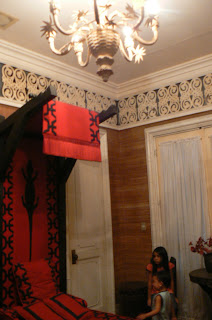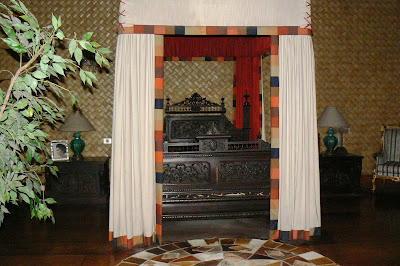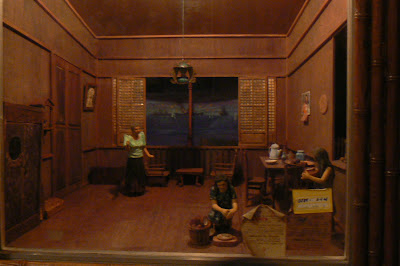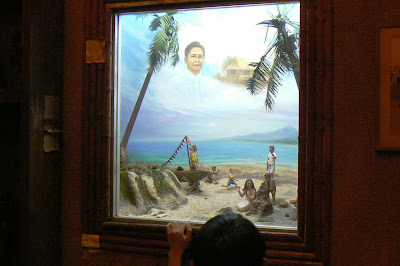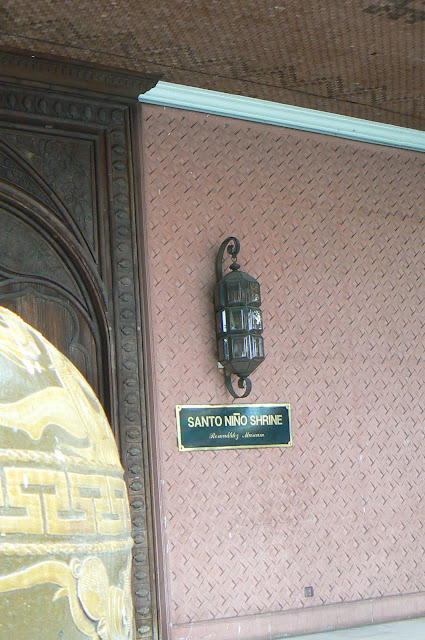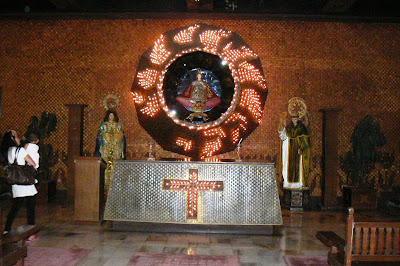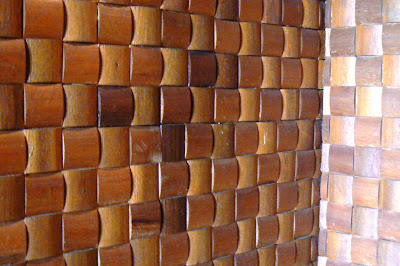Tacloban City, 22 March 2010 - As earlier mentioned, the Romualdez Museum, aka Santo Nino Shrine and Heritage Center, was built to flaunt the extravagant taste and "aristocratic origins" of former Philippine First Lady Imelda Romualdez Marcos.
Imelda's life is depicted in a series of dioramas in the first floor rooms of the Museum. Even more telling about how she wants to be portrayed to the world are the artworks in the second floor.
The huge Malakas at Maganda wooden art piece in a wall of the Firefly Room reflects the widely known desire of the Marcoses to be likened to the legend as the father and mother of the Filipino race, i.e. from whom all Pinoys come from. The legend tells about Malakas (meaning strong) and Maganda (meaning beautiful) coming forth from huge bamboos as depicted in the art piece shown in the photo above.
The Romualdez's family tree with Imelda at the top, showing her special status even within her family.
Imelda is depicted in this painting as the mother of all Filipinos, cradling them as mother nurturing her children. Nature's bounty is reflected in the richness of the seas. Her husband, Ferdinand, is relegated to the background (even partly concealed by the drapes) in the photo above.
View more photos of Romualdez mansion in previous posts:
Romualdez Museum (Santo Nino Shrine) in Tacloban, Leyte Part 1 (structure)
Romualdez Museum (Santo Nino Shrine) in Tacloban, Leyte Part 2 (dioramas)
Romualdez Museum (Santo Nino Shrine) in Tacloban, Leyte Part 3 (art pieces)
Romualdez Museum (Santo Nino Shrine) in Tacloban, Leyte Part 4 (bedrooms)
read more...
Imelda's life is depicted in a series of dioramas in the first floor rooms of the Museum. Even more telling about how she wants to be portrayed to the world are the artworks in the second floor.
The huge Malakas at Maganda wooden art piece in a wall of the Firefly Room reflects the widely known desire of the Marcoses to be likened to the legend as the father and mother of the Filipino race, i.e. from whom all Pinoys come from. The legend tells about Malakas (meaning strong) and Maganda (meaning beautiful) coming forth from huge bamboos as depicted in the art piece shown in the photo above.
The Romualdez's family tree with Imelda at the top, showing her special status even within her family.
Imelda is depicted in this painting as the mother of all Filipinos, cradling them as mother nurturing her children. Nature's bounty is reflected in the richness of the seas. Her husband, Ferdinand, is relegated to the background (even partly concealed by the drapes) in the photo above.
View more photos of Romualdez mansion in previous posts:
Romualdez Museum (Santo Nino Shrine) in Tacloban, Leyte Part 1 (structure)
Romualdez Museum (Santo Nino Shrine) in Tacloban, Leyte Part 2 (dioramas)
Romualdez Museum (Santo Nino Shrine) in Tacloban, Leyte Part 3 (art pieces)
Romualdez Museum (Santo Nino Shrine) in Tacloban, Leyte Part 4 (bedrooms)











